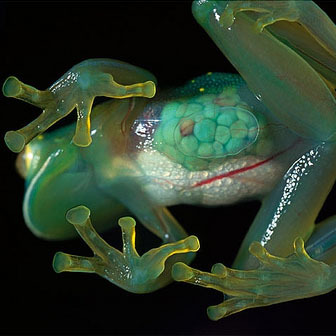Deduce The Weight Of This Frog
 Image source:
Mudfooted.com
Image source:
Mudfooted.com
A frog is jumping around a pond. At some time t , the frog is in the air and has a kinetic energy of 1 J and a momentum of magnitude 0 . 5 kg ⋅ m/s . What is the mass of the frog in kg ?
The answer is 0.125.
This section requires Javascript.
You are seeing this because something didn't load right. We suggest you, (a) try
refreshing the page, (b) enabling javascript if it is disabled on your browser and,
finally, (c)
loading the
non-javascript version of this page
. We're sorry about the hassle.
15 solutions
Good answer !
Okay .
We know that :
K i n e t i c e n e r g y = 2 m v 2 = 1 J
And that :
M o m e n t u m = m v = 0 . 5 k g ⋅ m / s
Therefore , by manipulating the formula for KE (i.e Kinetic energy) ,
2 m v 2 = 1
⇒ 2 1 ⋅ ( m v ) ⋅ v = 1
⇒ 2 1 ⋅ ( 0 . 5 ) ⋅ v = 1
⇒ v = 4
Putting v = 4 in the formula for momentum ,
We get m v = m ⋅ 4 = 2 1
⇒ m = 8 1 = 0 . 1 2 5
nice solution
P = 0.5 kg m/s
KE = 1 J
KE = (1/2)mv^2
P = mv
substituting equation for momentum into equation for kinetic energy...
KE = (1/2)(P/m)^2
1 kg m^2/s^2 = (1/2)(mass)[(0.5 kg m/s^2)/mass]^2
solving for mass, you obtain:
mass = 0.125 kg ]ans.
Kinetic Energy = 0.5 * Mass * Velocity^2
Momentum = Mass * Velocity
Kinetic Energy = 0.5 * Momentum * Velocity
v = Kinetic Energy * 2 / Momentum
= 1 * 2 / 0.5
= 4
Momentum = Mass * Velocity
Mass = Momentum / Velocity
= 0.5 / 4
= 0.125
thanks mate
Let p = momentum, K E = kinetic energy, v = velocity, and m = mass.
Recall that K E = 2 1 m v 2 and p = m v .
We now have a system of equations:
1 J = 2 1 m v 2 ( 1 )
0 . 5 k g × m / s = m v ( 2 )
Substituting ( 2 ) into ( 1 ) , we get 4 1 v = 1 m / s .
Therefore, v = 4 m / s ( 3 ) .
Substituting ( 3 ) into ( 2 ) , we get m = 8 1 k g = 0 . 1 2 5 k g .
Hence, the frog's mass is 0 . 1 2 5 k g .
p = mv |||||||||||| 1/2 = mv ||||||| v= 1/2m |||||||||||||||||||||||||||||||||||||| EK = 1/2 mv^2 |||||||||||||| 1 = 1/2 m (1/2m)^2 |||||||||||||||||||| 1 = 1/2 . m . 1/4m^2 |||||||||||||||||||||| 1 = 1/8 m |||||||||||||| 8m = 1 |||||||||||||||| m = 1/8 |||||||||| m = 0,125 kg
we know that K.E=P P/2M......SO m=P P/2 K.E=.5 .5/1*2=.125
we know, K.E= p^2/2m given m is mass of body, p is momentum nd KE is kinetic energy of the body.. so changing the equation as m=p^2/2KE nd placing the values we get the result
chor
It is the direct application of the formula
KE = p^2/2m
Where p is momentum of body
1J = 0.5^2/2m
1J = 1/8m
=>m = 1/8 = 0.125 Kg
First , 1/2 m v^2 = 1 joule , arrange it and we found v^2=2/m Then, input the value of v into the momentum, then we got the answer 0.125
Since kinetic energy = 2 m p 2 , 1 = 2 m 0 . 5 2 .
Therefore, 2 m = 0 . 2 5 and m = 0 . 1 2 5 .
So, the mass of the frog is 0 . 1 2 5 kg.
KE = 1/2 mv.v
Here p ( momentum ) = 0.5 kg. m/s
And KE (kinetic energy) = 1 joule (J )
Putting values of KE and p, we get
1 = 1/2 (0.5 ) v
2 = ( 0.5 ) v
V= 4
Also, p = mv
0.5 = m (4)
M = 0.125
MOMENTUM=mv-----------------------1, KINETIC ENERGY=1/2mv^2-----------------2, DIVIDING 1 AND 2,WE GET, MOMENTUM/KINETIC ENERGY=2/v
ACCORDING TO GIVEN CONDITION, 0.5=2/V V=2/0.5
KINETIC ENERGY=1/2mv^2 1 =1/2 m[4]^2 2/16 =m i.e 0.125 =m
so,you are living in mumbai
from the question we know that ,
p = 0 . 5 k g m / s or we can change to ⇒ m v = 0 . 5 k g m / s
2 1 m v 2 = 1 J ⇒ kinetic energy = 2 1 m v 2
m v 2 = 2 J
m v × v = 2 J
back to the top, cause m v = 0 . 5 k g m / s so we can write
0 . 5 k g m / s × v = 2 J ⇒ v = 4 m / s
substitute v = 4 m / s to ⇒ m v = 0 . 5 k g m / s
m × 4 m / s = 0 . 5 k g m / s
m = 0 . 1 2 5 k g
Note : m v = m a s s × v e l o c i t y
m / s = meter per second or velocity
1 Joule Equals 1 s 2 k g ∗ m 2